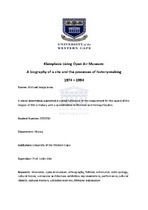| dc.description.abstract | In 1974 an Agricultural Museum Committee was established at the Worcester Museum which ultimately led to the development in 1981 of the Kleinplasie Open Air Farm Museum.This began a new phase in the museum’s history, one that I will argue was particularly closely linked to Afrikaner nationalist historiography, in particular to ideas about frontier farmers and pioneer farming lifestyles and activities.This study will take the form of a critical analysis of the establishment of Kleinplasie Living Open Air Museum from 1974 until 1994. It will evaluate the making of exhibitions, its architecture, and the performances and public activities in the establishment of the institution as a site of memory and knowledge. The key question this work engages with is how representations, performance, exhibitions, museum activities, and public involvement were shaped to create particular messages and construct a site of cultural identity and memory at Kleinplasie Living Open Air Museum.It will also deal with questions around who decides on the voices and content of the exhibitions, architecture and displays. The role played by professionals, those who claim to represent community, donors and other interests groups will also be placed under the spotlight. There are also questions around the provenance of collections, the way they were acquired through donations and sponsorships, and the crucial role objects played in the construction of the narrative and identity of the museum.A key question that emerges from my own work is the connection between the Afrikaner nationalist scholarship and the development of the open-air museum based on the life of the frontier farmer at Kleinplasie. While Kleinplasie does not seem to follow the monumental approach that was evident in schemes such as the Voortrekker Monument in Pretoria, where triumphalism and conquest are key metaphors, it does rely on a sense of
‘independence’ and self-fulfilment in social history type setting. There is thus a need to consider how Afrikaner nationalist historiography impacted on the way history was depicted at Kleinplasie. P. J. van der Merwe’s studies of the character and lifeways of the trekboer(Die Trekboer in die Geskiedenis van die Kaapkolonie), seems to have played a central role in the construction of the theme and narrative. This three-volume trilogy provided Kleinplasie(literally, ‘little farm’) with a social and cultural history on which to construct its version of the past. | en_US |

